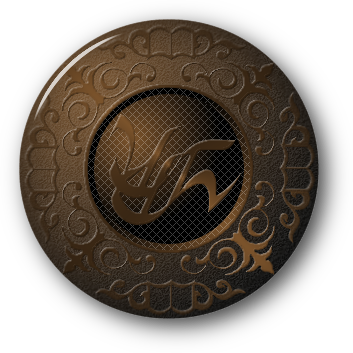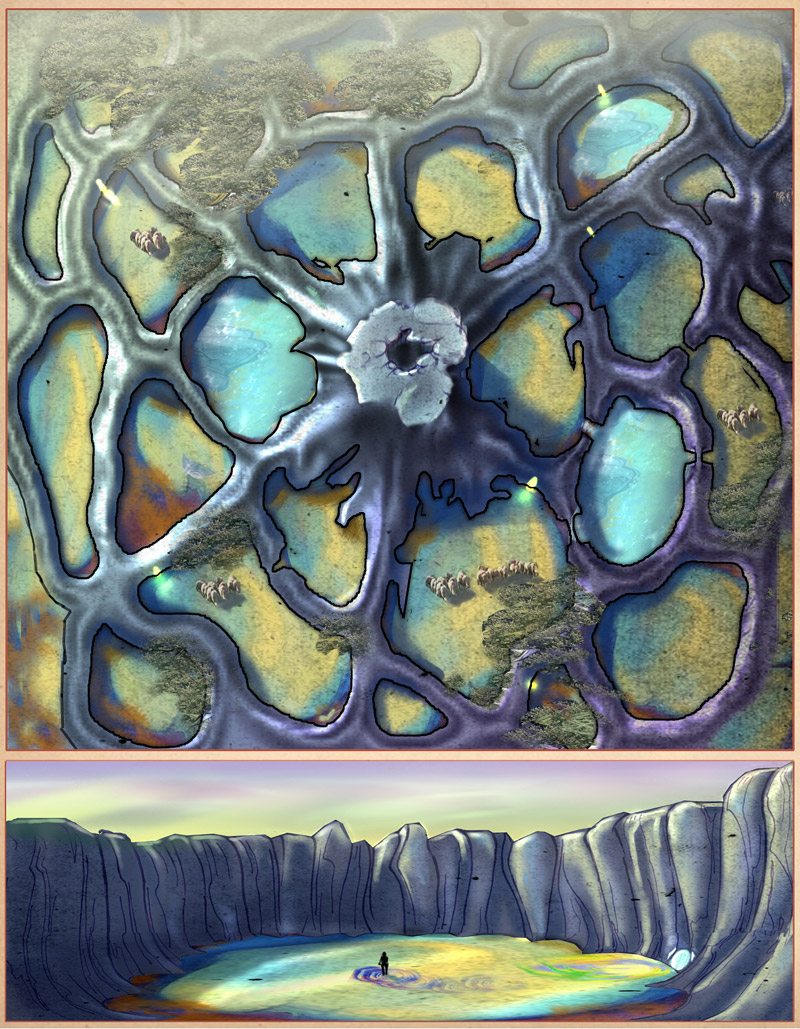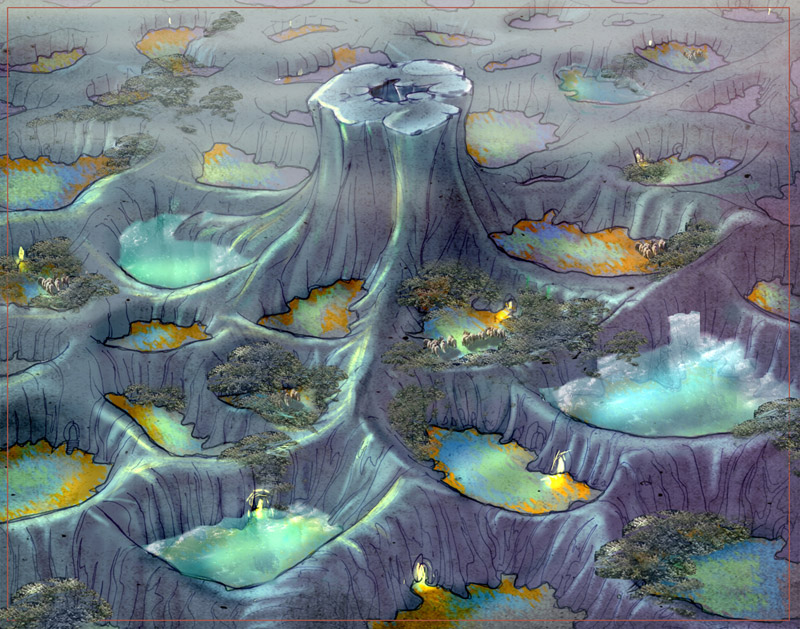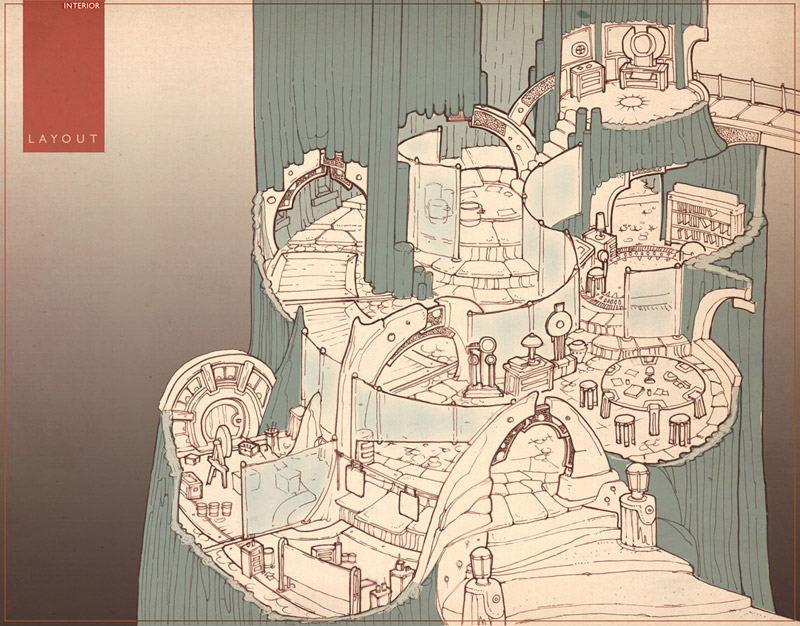

|
|
During a Town Hall Meeting on July 6, 2006, Dr. Kodama was pressed on the reasons for Pirahnay's suspension. He had this to say about it: "Strange place. An artist's Age, of sorts. Much of it can be manipulated and changed within the Age. There was also some backstory/history that was not particularly wholesome. Still trying to figure out much of it, although it's, quite simply, a very strange place that is even hard to understand what it should be restored to." There is no clue about the "unwholesome" history that Kodama mentioned in the available sketches. The DRC reviewed Pirahnay on September 30, 2006, and voted unanimously to renew the suspension. Thanks to documentation, we know quite a lot about the history of the Age. Pirahnay was written by members of the Guild of Writers around D'ni year 8579 for the Guild of Artists, one of the minor guilds formed when the Guild of Fine Artists was split up in D'ni year 2488. The translation of the name Pirahnay is unconfirmed, but since it's called the Pigment Age in DRC notes, it's possible that Pirahnay means "pigment root", with root having the connotation of "source". That's a common convention in many Age names. The D'ni home world, Garternay, means "great tree root" when translated literally, but probably should be read as "source of the Great Tree". Throughout the history of D'ni, there were people who wanted to write their own Ages but were forbidden to by laws that normally restricted the privilege to the Guild of Writers. However, that was subject to the golden rule: he who has gold makes the rules. That's why Aitrus, a master of the Guild of Surveyors, was able to write the Age of Gemedet and not only not be arrested, the D'ni Council even gave it back to him after confiscating it because he had allowed Anna to help him. Sometime around D’ni year 8579, a group of painters wanted to write their own Ages, but were frustrated because it wasn't allowed. They believed that Ages written by artists could be far more beautiful and creative than those written by the hidebound Guild of Writers. The artists eventually compromised by asking the Guild of Writers to create an Age just for them. The requested Age was to contain plants and materials they needed to produce pigments that could be used to make richer and more varied colors than materials found in the caverns. The writers and the city council agreed to create this artist’s Age and worked with the painters to write a world that would give them an endless array of colors. The artists were thrilled, and not just because of the resources they'd gain from the Age. They fully intended to use it as a place to conceal descriptive books that the painters were experimenting with. That had been the real motive for asking for the Age be written in the first place. When completed, the Age was covered with a color-shifting fungus. The artists could go to the Age, find the colors that they were in need of, scrape the fungus off the ground, and the harvested clumps of fungus retained the color. The artists then dried the fungus, ground it into a fine powder, and mixed it with an oil medium to make paint. But that wasn't all. The artists learned that when stimulated, the fungus could be induced to change into whatever colors they wanted, and it wasn't long before they knew how to get the fungus to change into the precise color desired. While they were mastering the resources of the Age, they secretly continued to learn the art of writing and spurred by their creative urges, they wrote book after book. That became a cause for worry because the number of books they were creating made them increasingly more difficult to hide. If the Maintainers were to find the books, the Age would be seized and the artists would lose access to Pirahnay and of the safety that it provided. After giving it some thought, they realized that there was a potential solution already in their hands. The paintings they were creating were popular in D'ni and were being constantly sold for hanging in homes, businesses and public places. If they could find a way to make the canvases work like books, then painted canvases would be a perfect place to hide the descriptive texts of the Ages they were writing. Nobody visiting the Age would think twice about a storeroom full of paintings in an Age devoted to painters. So the artists began to research ways to do on canvas what had always been done in books. That called for new materials to be created to produce such an effect and getting them would not be easy. However, the painters had friends in the writer’s guild who shared their vision of more creative writing, even if they knew that the rules and guidelines for writing Ages were there for good reason. These friends agreed to help the painters to secretly expand upon the artist’s Age and create new Ages with properties and materials that would aid the painters in the creation of their new types of ink and paper. So the artists began researching the ink and paper needed to create descriptive and linking books. That would not have been an easy task, because the exact formulas and processes for making those things were closely guarded secrets of the Guild of Books and the Guild of Ink Makers. They would have had to coax hints of the materials and procedures out of guild members without giving away the reason for their interest, and then experiment to find alternatives that would work for both linking and for painting. What they developed was a type of canvas made from a close approximation of the special paper used for descriptive books and a modified form of the ink used to write them. The new ink had a trick to it that would no doubt have astonished the ink makers. By applying certain chemicals, the ink could be made dormant, which the artists did after writing the Age. Even more surprising was the technical acumen the artists displayed when it came to the act of writing. Since they had to fit everything onto the surface of a standard sized painting canvas, they built devices that reduced the size of their writing to nearly microscopic. Once the writing was complete, the linking canvas was coated with a new formulation of gesso, a kind of primer used as a base for painting. It covered the writing and the linking panel so that they could not be seen, but it didn't harm their functions. The gesso also caused the ink to turn a color that was almost identical to that of the canvas, which further hid the writing in case any of the paintings were stripped off the canvas. But that wasn't the end of the lengths they went to to protect the secret. The artists developed a new formulation of paint that had a smoother consistency than the older type, but did not interfere with the linking panel underneath. The new paint bonded with the gesso and the underlying ink, and after it dried, the paint could not be removed from the canvas without also removing swaths of the underlying ink and destroying the canvas's function as a linking book. The chemical treatment and paint made the linking panel dormant, so it didn't light up and show through to the surface of the painting, but if anyone touched the area the panel was in, it still worked if touched. The artists painted an image of the Age that it linked to over the gesso so that they knew where it was going to take them without needing to see the linking panel. When they were finished, a special symbol would be applied to the piece. They could then link into one of their worlds through their painting by knowing just where to touch it. Something that should be pointed out is that the painters were not crazed or imprudent. They knew that poor writing could produce dangerous and unstable Ages. They took great pride in learning and understanding the Art of writing, and their friends in the Guild of Writers quietly taught them the rules they needed to follow to produce Ages that would be safe to visit. The painters understood the limits, and only the great master painters were allowed to produce paintings that worked as linking books. Just as the painters had friends who were writers, they also made friends with members of the Guild of Maintainers. The sympathetic maintainers tested their worlds for them to insure that they would be safe for visitors. As repayment to their writer and maintainer friends the artists created link-paintings especially for them. The recipients took the paintings back to D’ni and hung them in their homes to link through them whenever they pleased. The new Ages produced by the artists proved to be so original and beautiful that the owners were enthralled. They willingly kept the secret, but were permitted to share them with others whom they were sure they could trust. Eventually a secret market developed among those in the know, in which link-paintings could be commissioned at very high prices. The fact that the works were painted by known master artists accounted for their value to those unaware of their special properties. The symbol found on the paintings became a mark of exclusiveness available to only the highest ranking members of D’ni society. Humans being what they are, knowledge of these paintings eventually leaked, and rumors spread in the streets of D’ni. Over time, stories of incredible paintings that you could link into became widely known and the search for a magical paint that gave the images their power became obsession. This paint was, of course, never found and attempts at dismantling the paintings layer by layer and softening the paint to find its recipe resulted only in destroyed pieces of art. In the end, the original band of artists grew old and died. While exceptional paintings from Pirahnay continued to be produced right up until the Fall of D'ni and used the same high quality materials, the later paintings were made without the writing underneath. Over time, the story of paintings that could link fell into myth. The original link-paintings changed hands or were auctioned away at estate sales. Those paintings can occasionally be found in homes all across the city as well as in galleries and public buildings but the secret of how to use them was lost. The Age:
Inside the Butte:
|
Myst, the Myst logo, and all games and books in the Myst series are registered trademarks and copyrights of Cyan Worlds, Inc. Myst Online: Uru Live is the sole property of Cyan Worlds Inc. The concepts, settings, characters, art, and situations of the Myst series of games and books are copyright Cyan Worlds, Inc. with all rights reserved. I make no claims to any such rights or to the intellectual properties of Cyan Worlds; nor do I intend to profit financially from their work. This web site is a fan work, and is meant solely for the amusement of myself and other fans of the Myst series of games and books. |
 Pirahnay is an Age that was first listed in the DRC's restoration projects list in January of 2004. I was suspended in phase as "not understood, dangerous to proceed without knowledge".
Pirahnay is an Age that was first listed in the DRC's restoration projects list in January of 2004. I was suspended in phase as "not understood, dangerous to proceed without knowledge".
